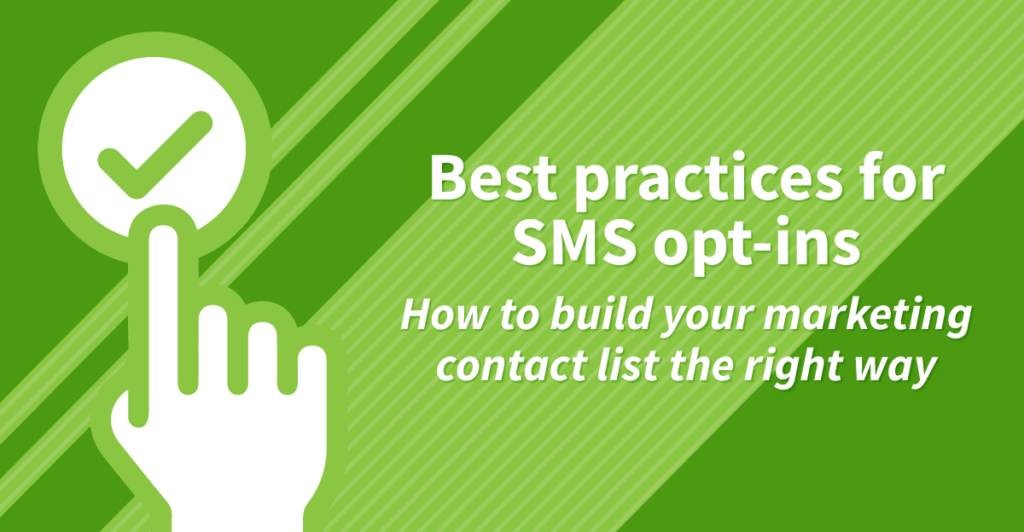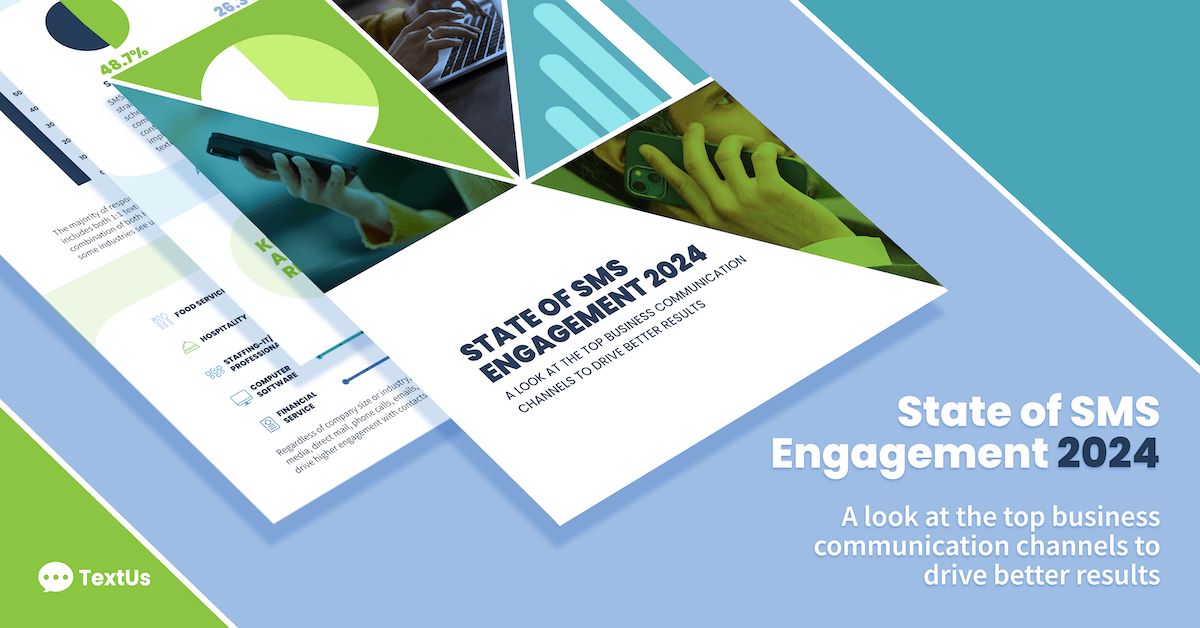Best practices for SMS opt-ins

There’s an adage that says it’s better to seek forgiveness than ask permission. Whoever said that did not work in the telecommunications industry. Whether you implement email or SMS marketing strategies, or have other communication platforms, you should be aware of the guidelines, laws, and best practices of customer opt-ins.
This is part one of a two-part series on best practices for collecting and maintaining contacts.
What is SMS opt-in?
SMS opt-in is a way in which businesses collect permission to subscribe contacts into receiving text message communication. SMS opt-in assures compliance and trust within the text messaging community and eliminates the risk of spam.
Contacts who know they are willingly receiving SMS communications and what that entails are more likely to have a better relationship with the business sending the text messages. This means better deliverability, response rates, and engagement. Common ways of collecting opt-ins for text messages include online and physical forms, SMS keywords, email marketing, and website pop-ups.
Since there are multiple channels users may opt-in (through email, SMS, websites) your first text message should reconfirm the outreach and what users can expect as you add SMS to your communications strategy. Just because someone subscribes to your email marketing or other channel, that does not give expressed consent to receive text message marketing.
Is there a difference between email and SMS opt-in definitions?
Both SMS and email communication look at explicit or implied consent for reaching out. Explicit consent relates to marketing and promotional communication where there is a clear, call-to-action or link and users agree to receive that communication. Implied consent may relate to conversational communication where a user may message you first with regards to a product or service so it’s implied they want to talk.
HubSpot defines opt-in as: “a situation where contacts themselves submit their email address to an organization, and have the expectation that they’ll receive marketing emails as a result.”
Both email and SMS require opt-ins for marketing communication to stay compliant but they may approach it differently and also may be easier to overlook in some cases. For example, in sales, you may be able to get scrappy and collect emails through LinkedIn or websites. Most business contacts have email addresses on their website or LinkedIn. If your exact contact isn’t listed, you may be able to follow a pattern to make an educated guess about a contact.
Let’s say joe@abcompany.com is listed on the website and you are looking to add a Trevor to your list; you may try trevor@abcompany.com and hope it is right or that it will redirect to an alias. While these tactics show research and dedication, if you aren’t asking for permission to make sure Trevor wants to be on your mass marketing lists, you could face serious consequences. This is different from sending a 1:1 email to Trevor or a LinkedIn message.
Because email marketing has been around for a longer period of time than SMS marketing, the chance of having lists that are not accurate or compliant are high. Most users may not list their phone numbers (especially mobile) online and since some landlines may not be text-enabled (learn how to enable a landline for SMS), it’s a harder guess than email addresses. With turnover in marketing and sales, you probably have had many different hands and methods touching your email lists and may have not collected appropriate opt-ins along the way.
This can include things like collecting business cards and manually entering emails into your database, taking a transactional email response and adding to your promotional marketing lists, and buying lists. Let’s say someone buys a product and adds their email to get their receipt, that’s a transactional email, but if you take that and add it to your Black Friday marketing lists without asking for permission, you may be in violation. A customer can unsubscribe (even though they didn’t subscribe) or worse, mark you as spam and give you a red flag. Enough red flags and your entire domain could be at risk.
To collect opt-ins for both email and SMS marketing, you will either have a single or double opt-in. A single means that a user only needs to check or confirm subscribing to your list once. A double opt-in would mean that after signing up to receive emails or text messages from your company, users would receive a link either to their email or SMS to confirm (again) that they are choosing and want to receive this content.
Which laws govern email and SMS opt-in requirements?
SMS is regulated by the Telephone Consumer Protection Act (TCPA) passed by Congress in 1991. The goal of TCPA is to protect consumers from unwanted solicitations (aka spam) from third parties who are marketing products or services over the phone, via voice, or text.
Contacts you are reaching out to should be expecting a message. If you are contacting them about a product or service, then you will require an opt-in to do so. Sending text messages that don’t involve marketing a product or service (eg, new job openings) do not require an opt-in per TCPA. Even though the law doesn’t require an opt-in for such messages, mobile network operators oftentimes will require an opt-in because they have no way of reliably discerning marketing-related messages from other ones.
You should always consult an expert about your specific use case and what your organization does or doesn’t have to do around SMS opt-in. You should also follow the national do not contact registry and check your database regularly. Some of the guidelines will also depend on your location. TCPA does not apply to emails even if you are looking at email on a mobile device.
The Federal Communications Commission (FCC) website states that “Congress passed the CAN-SPAM Act to address the problem of unwanted commercial electronic mail messages. The CAN-SPAM Act requires the Federal Communications Commission to issue rules with regard to commercial email and some text messages sent to wireless devices such as cell phones—not email in general. Specifically, section 14 of the CAN-SPAM Act requires the Commission to develop rules to protect consumers from “unwanted mobile service commercial messages.” The rules and guidelines of CAN-SPAM affect both email and SMS.
The strictest of laws comes from The EU General Data Protection Regulation (GDPR). “The purpose of the GDPR is to protect individuals and the data that describes them and to ensure the organizations that collect that data do so in a responsible manner.” This includes how and why you collect email addresses, but is limited to email only and monitored in the European Union and not the United States.
How do mobile carrier acceptable use policies affect SMS opt-in requirements?
Mobile carrier acceptable use policies ensure that users and partners on the carrier plan consent to not violate any of the laws, including collecting and sending unwanted messages. These policies seek to keep bad actors out of the SMS industry and prevent abusing the technology.
Acceptable use can dictate clear registration for senders, protect the privacy and security of users, as well as prohibit illegal content and activities such as spamming, phishing, and misrepresentation or impersonating.
From an opt-in perspective, these policies can mandate that you clearly tell users what to expect from your content, are clear and transparent, describe how you collect and use their data, and provide ways to opt out.
While mobile carriers can not create and regulate laws, they are able to enforce their own rules and guidelines in order to filter text messages and protect consumers. We see this in things such as 10DLC which was carrier led and secures and improves business-to-consumer text messaging, also known as A2P (Application-to-Person).
10DLC seeks to build and maintain trust between businesses and consumers by establishing routes and validity for sending messages. It rewards companies who know their consumers and provides wanted content to them.
In 2022, mobile carriers expanded the toll-free verification process to opt customers into receiving mobile SMS marketing. An end user has to add their opt-in policy and a screenshot of how and where they collect the opt-in. Toll-free verification requires a clear and concise opt-in policy. The most common way that we have seen with customers is to have an opt-in box that says someone can contact them. These opt-in forms are different from your terms and conditions.
How do you opt-in contacts to receive marketing communication?
Given the significance of compliance in communications, here are several tips to ensure your contacts are getting the best experience with your content and delivery.
- Send double opt-ins and make sure users want to receive your content. You may want to periodically send an opt-in message just to confirm your list is accurate. You can offer changes to how often or what users are receiving so they can personalize the experience. Performing regular audits will keep your lists updated not only for compliance but also for metrics to keep delivering content to the most engaging contacts.
- Use keywords to automate compliance. SMS keywords can be used in a variety of ways within business texting, such as simplifying opt-ins and growing a subscriber list for SMS campaigns. Making your keyword memorable will help get more people to text in your keyword. You can tie the keyword to your brand, your campaign, or use common terms. For example, you can use the keyword “JOIN” as an easy way to opt-in subscribers.
- Use a text messaging platform. An SMS platform can help organizations stay compliant with built-in features and partnerships for success. TextUs functionality includes software that reminds users how to write messages in a way that is more engaging or less offputting, which minimizes the chance of an opt out. TextUs also helped customers register with 10DLC and get toll-free verification. Phone numbers entered into TextUs are read by our system to try to determine whether they are a mobile number that is able to be texted or not to improve deliverability.
- Provide a way to opt-out. Be sure to read part two of this series which will be all about opt-outs!
Disclaimer: this is not legal advice. You should always consult with a legal expert and verify with your mobile carrier on specific guidelines and laws that impact your business communications.
Be sure to contact us today for more information!

Get a TextUs Demo
Learn how thousands of businesses use TextUs everyday to communicate in real-time.




